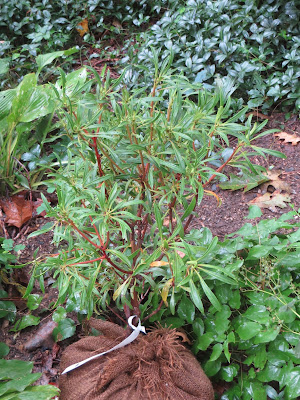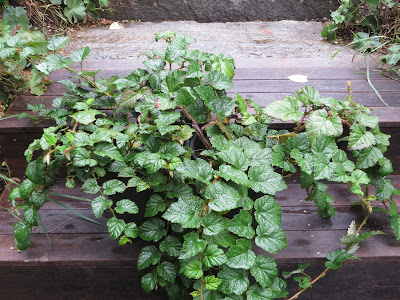Going south to nurseries is always trouble. Something I often conveniently choose to forget. Last week, I made the three-hour pilgrimage to Broken Arrow Nursery in Hamden, CT in search of woody plants for the woodland garden. Broken Arrow is a nursery specializing in "uncommon and underutilized" woody plants and perennials. They often attend gardening symposiums (Hollister House, North Hill and Sakonnet) with a truckload of plants, many of which I have no business growing in New Hampshire.
The plant list at Broken Arrow gets more interesting and dangerous every year. The highlight of the biannual Hollister House symposium is a show-and-tell of interesting plants with Marco Polo Stufano, the former Director of Horticulture at Wave Hill, garden writer Paige Dickey and Broken Arrow's Adam Wheeler-- each expert trying to one-up the others by introducing the audience to new and tantalizing plants to try in their gardens. Wheeler, the Plant Development Manager at Broken Arrow, always has something in his arsenal that I simple must have--until I find out it is only hardy to Zone 6. Usually I let common sense prevail in a situation like that, but this trip I let temptation get the better part of me.
First thing, when I get out of the car, is to check out the display beds throughout the nursery. It is a great way to see many of the plants in the catalogue in-situ. Nearly all he plants are labeled. This elegant tree was so robust I couldn't find the label. I believe this plant is weeping form of Styrax japonicus.
Next, I like to walk through all the nursery beds. They are organized by trees, shrubs and perennials. The perennials are further categorized by shade and sun. This is the Deciduous Shrub Area. I usually walk through the entire nursery before getting a cart. I need to see "the forest for the trees" before actually selecting plants for purchase.
More Deciduous Shrubs--the end of the alphabet.
This is the Shade Perennials Area
Beginning to fill the cart at the Deciduous Trees area.
Chris Koppel, the Sales Manager, was very knowledgeable. He never hovered but always seemed around the corner available for questions. Like all good gardeners, he was very opinionated, and extremely helpful. The website describes him as a "city kid with a farmer's soul, Chris brings a modern mind to our classic nursery. His passion for Japanese garden design and world travel gives him great perspective." Now for the take home; the plants that made the grade this trip:
I fell for Rubus tricolor, known as the Creeping Bramble, as soon as saw that it was a "tough-as-nails" groundcover for slopes in a wide range of light conditions including dry shade. The attractive glossy, green, three-lobed foliage also caught my eye. It grows 12' tall and 12 feet wide. It has white flowers in early summer followed by edible red fruit later in the summer. It is a Zone 6 plant but if it is so tough, why can't it handle Zone 5? I was thinking our minimum winter temperatures are slowly creeping up. Maybe it will survive in New Hampshire. We'll see.
Clethra anifolia is hardy to Zone 4, so I am playing it safe with 'Sherry Sue', an intriguing cultivar of summersweet that has a pinkish-red stem coloration on new growth which is maintained throughout the growing season. I had seen stands of clethra growing wild on a recent trip to Cape Cod which reminded of this New England stalwart and I decided to add it to the woodland garden.
Rhus coppalina is another plant I actually saw naturalizing at our friend's house at the Cape this summer. At first, we thought it might be poison sumac but after closer inspection we determined it was another sumac commonly known as flameleaf sumac due to its crimson fall color. This cultivar called 'Lanham's Purple' and boasts rich burgundy foliage that holds its color the entire season. I am going to use it on a steep bank in full sun which should be the perfect application for this colonizing 15-20 foot shrub. It is hardy to Zone 4, so again I'm safe.
I first saw Callicarpa bodinieri 'Profusion' at the Arnold Aboretum when I took the propagation course there almost 20 years ago. This beautyberry is hardy to Z6 but is described as a "vigorous, upright-arching shrub growing to a height of 6-8’ with a similar spread. The deep green, oval leaves emerge flushed with attractive bronze-purple tones and pick up two-toned golden-yellow autumn hues. At their best in late August when a stunning display of purple berries develop and remain attractive past leaf drop and into December. Plants are pest and disease free giving excellent results in rich soils in both sun and part shade locales." I have recently learned that callicarpas flower and fruit on new wood so even if it dies to the ground each year, I should get the fruit. Again, time will tell.
Gelsemium sempervirens 'Margarita', aka Carolina jessamine or trumpetflower, is a native climbing plant from Virginia to Texas to Florida. It is relaibly hardy to Zone 6. 'Margarita', a clone discovered by Don Jacobs of Eco Gardens in Decatur, Georgia, has larger-than-normal yellow flowers in early summer. I've read that it has survived winters to minus 25 F, so I thought I'd give it a try on a protected spot on a south-facing trellis on our terrace.
Hydrangea quercifolia 'Snowqueen' should not be a problem in my garden. I already have this clone planted under the Acer griseum x "Gingerbread' near the terrace. This one will go in the woodland. Its huge leaves will add a much needed contrasting texture in the garden. This native plant, called the oakleaf Hydrangea, has flowers in June and excellent fall color. This cultivar is supposed to be particularly tough, guaranteeing that it will be able to hold up its huge flowers without flopping.
Aronia melanocarpa 'Autumn Magic' is another hardy native plant with beautiful fall foliage. This clone grows to 3-5 feet and has small white flowers which appear in spring and are followed by abundant crops of large, purple-black fruit that persist for months, sometimes into winter.
Acer shirasawanum 'Autumn Moon' will grow to 8-10 feet and 6-8 feet wide. It has, as its name suggests, excellent fall foliage. The leaves emerge rose-pink and evolves to chartreuse with pink highlights. Late in the season it climaxes to shades of gold to red. Again, the foliage texture will be a plus in the woodland. It is hardy to Zone 5, another safe plant in New Hampshire.
My final selection was Styrax japonicus var. fargesii. I have always read that Styrax japonicus, the Japanese snowbell, was marginally hardy in Zone 5, so several years ago, I opted for Styrax obassia, which is solidly hardy in New Hampshire. This clone is supposed to be hardier than other selections and has "luxuriant glossy purple cast leaves and abundant starry white, bell-shaped flowers. Though new to cultivation our initial impression suggests that plants will be good growers with an upright form." They say hardy to Zone 5. I'm going to believe them; after all, they are the experts.


















I make the trip to Broken Arrow several times a season too (from northern CT). In fact I also picked up a styrax var. fargesii this year from them. I am technically in zone 6, but in a low swale microclimate that is really zone 5 and gets colder temps than surrounding areas -- we're both experimenting a little with this snowbell!
ReplyDeleteYour haul of interesting and unusual plants is great. They really are helpful and go out of their way at this nursery. They hunted for over 45 minutes for just the Parrotia I wanted -- and found it for me. My favorite nursery -- I'm glad you make the trip down. I'll want to see how all of your new plants do next season.
Hi Laurrie. I'm pretty sure our snowbell will work. Some of my other plants, I'm not sure. I know I can't do anything about climate change but I may as well experiment with plants that I didn't dare try 20 years ago. Which parrotia did you get? I have 'Vanessa' which, like Styrax japonicus var. fargesii, has an upright habit--perfect for the small garden.
DeleteYep, I got 'Vanessa' because it had to go at the back of a border between a big maple and a sweetgum, so it has to stay narrow. Lovely tree. I hope to see a post of your 'Vanessa'!
DeleteMichael, you seem to be entirely in your element as The Plant Hunter. ( I don't understand your Zones, we having here a different definition of climates )
ReplyDeleteWhat wonders you've returned home with. In another life I see you as the keeper of a vast botanic garden, with a highly cultivated sense of what is particularly right.
Your garden can only be getting more beautiful. Do you ever open it?
You're a visionary in more than one sense?
Yes, Faisal, I like the hunting part. I am especially interested in foliage texture, autumn color and winter form.However, I may have bought my last tree because I have such a small garden. The design and how the plants are put together is equally important to me. Maybe in the next life, I will graduate to a larger property. For this life, the public gardens give me an opportunity to try other plants and design ideas. The garden is open for a tour every couple of years depending on what is happening. Interestingly, there is a group from Australia visiting gardens throughout the Northeast during autumn next year. I'm certain mine will be the smallest garden the will see. They are seeing some of the most spectacular gardens in the US. They will be here for about an hour (or less) I'm thinking, but I am already planning for their visit.
DeleteFaisal, I forgot to mention that our zones are determined by minimum temperatures. Zone 5 is -29 C and Zone 6 is -23 C.
DeleteA nursery I've never visited but am familiar with through gardening friends on the East Coast, who have the most amazing woody plants in their gardens, lots of them bought at BA. Here in SoCal the gardens can be filled with wonderful succulents and woody lilies, but East Coast gardens can lay claim to the most amazing shrubs.
ReplyDeleteYes, Denise we have some great woodies to choose from here. I'd love to do some of the succulents that you get to use!
Delete